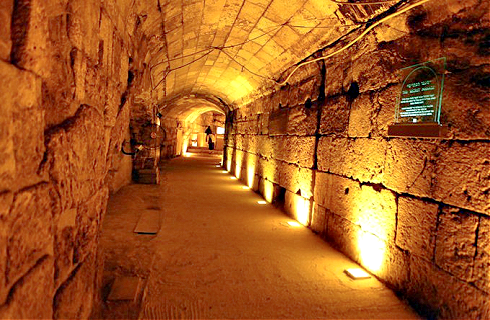Archives
AND MORE...

Theater Of The Absurd
_____________________

Remarkable Discovery In Jerusalem
_____________________

Some Inconvenient Facts
_____________________

Where's The Outrage?
_____________________
December 25, 2020
Unearthing History
The archaeological tunnels and excavations of Jerusalem's Old City received an award from the International Tunneling and Underground Space Association (ITA) this year (see below).
Israel's project is very archaeologically focused, especially given the rich history that lies beneath the surface of much of the country, especially in cities thousands of years old like Jerusalem.
"Tunnel design and building expertise in soft grounds and archaeological fill is required in order to proceed with the excavations and make the site accessible to the public," the ITA said on its website.
"The sensitive environment demands great dexterity and flexibility."
Jerusalem Post | December 25, 2020
Jerusalem Old City Tunnels Receive International Recognition
The tunnels earned the top spot in the "Oddities of the Underground" category unique to the 2020 ITA Tunneling Awards.
By Jerusalem Post Staff

The tunnels beneath the Western Wall. (photo credit: ABIR SULTAN/FLASH90)
The archaeological tunnels and excavations of Jerusalem's Old City received recognition from the International Tunneling and Underground Space Association (ITA) this year, during the ITA's most recent award ceremony.
The tunnels earned the top spot in the "Oddities of the Underground" category unique to the ITA Tunneling Awards.
The 2020 awards, given out virtually due to the coronavirus pandemic, were focused on various innovations and accomplishments in the field of tunneling. Awards are not purely archaeological in nature, and in fact most of the eight categories were given to projects related to railroads and construction.
But Israel's project is very archaeologically focused, especially given the rich history that lies beneath the surface of much of the country, especially in cities thousands of years old like Jerusalem.
And it is in Jerusalem where much of the real innovation in archaeological tunneling can be seen.
The awarding body placed the tunnels in the oddities category, considering the excavations attracts millions of tourists each year - putting the findings on full display - even while "the entire extent of the archaeological site has not yet been fully explored."
The process in which the tunnels are made, and then made available to the public also earned the archaeological site consideration within the category.
"Tunnel design and building expertise in soft grounds and archaeological fill is required in order to proceed with the excavations and make the site accessible to the public," the ITA said on its website. "Excavation is carried out underground, manually, using steel ribs and steel plates as temporary and permanent support.
"The sensitive environment demands great dexterity and flexibility."
Additionally, the unique manner in which the findings of the site are collected and the technologies used to carry out the excavations forwarded the tunnels' place within the category.
"Due to site complexity derived from small excavation area and risks of shallow tunneling in urban area, special excavation technologies are executed, such as custom-made drill machines adapted to small spaces," the awarding body said. "In addition to that, special measures are to be taken in order to consider the archaeological findings and to protect them during excavation.
"Unlike conventional excavation in which the muck is being moved away, the nature of this project is to keep the muck for further research by scientists."
Original article here.
Log In »
Notable Quotables
"Mr. Netanyahu is one of the most media-savvy politicians on the planet. On Friday he appeared live via video link on 'Real Time with Bill Maher,' taking the host’s alternately sardonic and serious line of questioning with gazelle-like alacrity."
~ Anthony Grant, jourrnalist who has written for many major newspapers and worked in television at Paris and Tel Aviv, interviewing former PM Benjamin Netanyahu on Monday, at the outset of Mr. Netanyahu's new book (more here).


